Featured Russian Artist Dmitri Baltermants
Fine art oil paintings for sale
Posted on March 15, 2016
Baltermants was arguably the greatest Soviet photographer of the second half of the 20th Century. View his work here
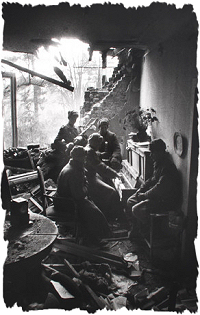
Of the numerous stars that shone in the bright constellation of Soviet Photography the star of Dmitri Baltermants was one of the brightest. It was especially conspicous since it was shining in the very center of that constellation. As the principal photographer and photo editior of OGONYOK magazine, Baltermants achieved what words could not. Over a span of five decades, he captured on film the life, the times and the spirit of the Soviet people and the nation they built.
When I mention "Soviet photography" it was not a slip of the tongue. Like everywhere that was Soviet, our photography was an island isolated from the rest of the world. Even when the winds from the mainland reached our island they did little to change the island's climate. Social realism, which dominated our country's literature, cinematography and art, affected photography too. Naturally, as a permanent leader of Soviet photography, Baltermants was unsurpassed as the leading practitioner of social realism. He was a virtuoso of "staged photography" which for many years remained the only "officially recognized" photographic style of the Soviet Union. However, Baltermants' images were always unique and recognizable as his own, as Baltermants' photography and his personality were inseparable.
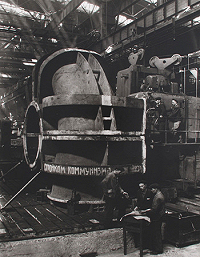
Baltermants, the artist and photojournalist, was able to touch the people's innermost feelings, yet he confidently followed the official line. His recognition today as the greatest Soviet photographer of the second half of the 20th Century seems partly due to the fact that his photographs were routinely published in OGONYOK magazine, where its readers saw all major development in the country's life through the eyes of Baltermants. His popularity during his lifetime can hardly be explained by this reason alone. His high cultural level combined with a broad outlook, perfect taste, and a gift for analytical thinking helped the photographer discern numerous details in his photographic subjects that left many of his colleagues indifferent. Baltermants' superb skill and his ability to choose the optimum light and angles insured that all reflections caught by the camera lens became an indispensable feature of the image. The greatest gift of an artist is rich imagination. Baltermants had this talent in full measure. When an artist's feelings blend with the sentiments of the people around him, then he creates and artistic image and a true work of art.
Perhaps this ability to choose only what was essential for the photograph and cast aside the rest, explains why despite all fluctuations in tastes and fashions each photographic image in this portfolio remains important and worthy of attention. His photographs shed light on the events of the past and help us see the past from the right prospective.
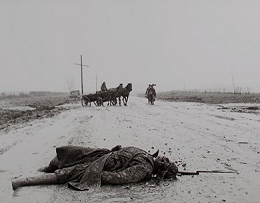
Baltermants' work during World War II stands out as particularly important and fruitful. Despite his young age, the photographs of that time show the tragedy so comprehensively and truthfully that they become symbols of a deep humanism. Many years had to pass after the end of the war until finally the first photographs of our wounded, murdered, and tortured countrymen appeared at photo-exhibitions, and the glorious picture of the war was marred with blood. Every illustration of the "dark side" of our victory shocked the spectator, made him shudder, and gave rise to thought. But war marked only one period in the master's art, the brightest, but at the same time the shortest.
As for the longest period of his work, it began after the war in the 40's and lasted into the 80's. It was the time of major construction projects, space exploration, new leaders and new contacts with other nations. Baltermants lived a very active life. He was ready to cover every new development. He provided the most vivid, interesting, and comprehensive reports about Soviet people "rediscovering" foreign countries and other continents, building giant power plants and the emergence of the nation into the atomic age. In all of these situations the top-quality work of Soviet people was matched by the equally superb reports of Dmitri Baltermants. He was a brilliant interpreter of the idea of "triumphant socialism."
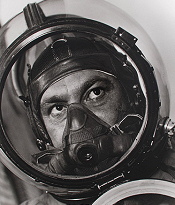
His every trip to any part of the Soviet Union was long remembered by local bosses and their retinues not only because the reporter was a charming person, not only because every major business trip was discussed in minute detail well in advance and not only because after the visit Ogonyok would broadly cover it, but because the picture drawn by Baltermants surpassed in optimism their authorities' vision of the place where they lived and their achievements. His interpretation made them look more significant and impressive. Apparently, the isolation of our system from the rest of the world created something like a green-house effect. Inside the glass walls of the green-house we saw ourselves in a more favorable light, we seemed more important and righteous in our own eyes.
In the last period of his life, Baltermants worked less; however, he continued photographing the country's leaders. And it was in these photographs that he discovered a new Baltermants. From his archives, he collected images which represented almost half a century's worth of portraits of the figures of power: the "anatomy" of Soviet power. he hadn't had to develop a critical attitude toward this or that statesman, all he had to do was honestly photograph everything that seemed expressive and which had caught his eye. It was during this period that Baltermants realized what he and his camera had witnessed, the transition of a nation, and it was his visions that the nation's people saw and remembered.
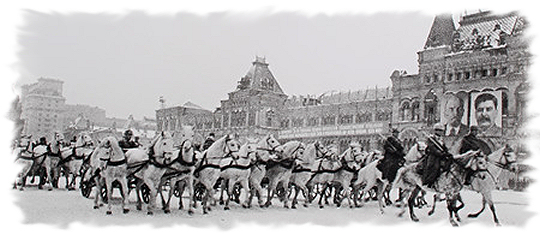
I doubt that Baltermants ever made any compromise with his conscience. And it is not for us to judge whether this talented man followed the right path. But one thing is clear -- had he lived in other conditions his art in peaceful times would have matched his war time masterpieces. Baltermants died at the age of 78 still full of energy and new ideas. He left behind a vivid panorama of his time with its achievements, experiences, and tragic mistakes.
-- Lev Sherstennikov, Moscow, Russia (1992)
Click here to see more work by this featured Russian artist.
Post a comment...
All recent posts and archives...




